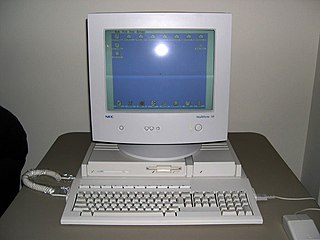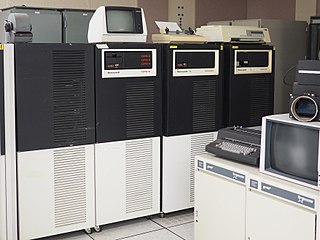
Alpha is a 64-bit reduced instruction set computer (RISC) instruction set architecture (ISA) developed by Digital Equipment Corporation (DEC). Alpha was designed to replace 32-bit VAX complex instruction set computers (CISC) and to be a highly competitive RISC processor for Unix workstations and similar markets.

The Intel 386, originally released as the 80386 and later renamed i386, is the third-generation x86 architecture microprocessor from Intel. It was the first 32-bit processor in the line, making it a significant evolution in the x86 architecture. Pre-production samples of the 386 were released to select developers in 1985, while mass production commenced in 1986. The 386 was the central processing unit (CPU) of many workstations and high-end personal computers of the time. The 386 began to fall out of public use starting with the release of the i486 processor in 1989, while in embedded systems the 386 remained in widespread use until Intel finally discontinued it in 2007.

The PDP–11 is a series of 16-bit minicomputers originally sold by Digital Equipment Corporation (DEC) from 1970 into the late 1990s, one of a set of products in the Programmed Data Processor (PDP) series. In total, around 600,000 PDP-11s of all models were sold, making it one of DEC's most successful product lines. The PDP-11 is considered by some experts to be the most popular minicomputer.

VAX is a series of computers featuring a 32-bit instruction set architecture (ISA) and virtual memory that was developed and sold by Digital Equipment Corporation (DEC) in the late 20th century. The VAX-11/780, introduced October 25, 1977, was the first of a range of popular and influential computers implementing the VAX ISA. The VAX family was a huge success for DEC, with the last members arriving in the early 1990s. The VAX was succeeded by the DEC Alpha, which included several features from VAX machines to make porting from the VAX easier.
The NS32000, sometimes known as the 32k, is a series of microprocessors produced by National Semiconductor. Design work began around 1980 and it was announced at the International Solid-State Circuits Conference in April 1981.
The 88000 is a RISC instruction set architecture developed by Motorola during the 1980s. The MC88100 arrived on the market in 1988, some two years after the competing SPARC and MIPS. Due to the late start and extensive delays releasing the second-generation MC88110, the m88k achieved very limited success outside of the MVME platform and embedded controller environments. When Motorola joined the AIM alliance in 1991 to develop the PowerPC, further development of the 88000 ended.

Convex Computer Corporation was a company that developed, manufactured and marketed vector minisupercomputers and supercomputers for small-to-medium-sized businesses. Their later Exemplar series of parallel computing machines were based on the Hewlett-Packard (HP) PA-RISC microprocessors, and in 1995, HP bought the company. Exemplar machines were offered for sale by HP for some time, and Exemplar technology was used in HP's V-Class machines.

Ultrix is the brand name of Digital Equipment Corporation's (DEC) discontinued native Unix operating systems for the PDP-11, VAX, MicroVAX and DECstations.

The Zilog Z8000 is a 16-bit microprocessor architecture designed by Zilog and introduced in early 1979. Two chips were initially released, only differing in the width of the address bus: the Z8001 (23-bits) and Z8002 (16-bits).
Pyramid Technology Corporation was a computer company that produced a number of RISC-based minicomputers at the upper end of the performance range. It was based in the San Francisco Bay Area of California
Convergent Technologies, Inc., was an American computer company formed by a small group of people who left Intel Corporation and Xerox PARC in 1979. Among the founders were CEO Allen Michels, VP Engineering Bob Garrow, head of marketing Kal Hubler, and operating system architect Ben Wegbreit. Convergent was primarily an OEM vendor with their computers resold by other manufacturers such as ADP, AT&T, Burroughs, Four-Phase Systems, Gould, Mohawk, Monroe Data Systems, NCR, and Prime. The company was purchased by Unisys in 1988.

The DECstation was a brand of computers used by DEC, and refers to three distinct lines of computer systems—the first released in 1978 as a word processing system, and the latter two both released in 1989. These comprised a range of computer workstations based on the MIPS architecture and a range of PC compatibles. The MIPS-based workstations ran ULTRIX, a DEC-proprietary version of UNIX, and early releases of OSF/1.

The Atari TT030 is a member of the Atari ST family, released in 1990. It was originally intended to be a high-end Unix workstation, but Atari took two years to release a port of Unix SVR4 for the TT, which prevented the TT from ever being seriously considered in its intended market.

The Sun-2 series of UNIX workstations and servers was launched by Sun Microsystems in November 1983. As the name suggests, the Sun-2 represented the second generation of Sun systems, superseding the original Sun-1 series. The Sun-2 series used a 10 MHz Motorola 68010 microprocessor with a proprietary Sun-2 Memory Management Unit (MMU), which enabled it to be the first Sun architecture to run a full virtual memory UNIX implementation, SunOS 1.0, based on 4.1BSD. Early Sun-2 models were based on the Intel Multibus architecture, with later models using VMEbus, which continued to be used in the successor Sun-3 and Sun-4 families.

Encore Computer Corporation was an American computer company independently active from 1983 to 1997. Based in Marlborough, Massachusetts, the company was an early pioneer in the parallel computing market. Although offering several system designs beginning in 1985, Encore was never as well known as other companies in this field such as Pyramid Technology, Alliant, and the most similar systems Sequent and FLEX.

The VAX 8000 is a discontinued family of superminicomputers developed and manufactured by Digital Equipment Corporation (DEC) using processors implementing the VAX instruction set architecture (ISA).
The VAX 9000 is a discontinued family of mainframes developed and manufactured by Digital Equipment Corporation (DEC) using custom ECL-based processors implementing the VAX instruction set architecture (ISA). Equipped with optional vector processors, they were marketed into the supercomputer space as well. As with other VAX systems, they were sold with either the VMS or Ultrix operating systems.
The ICL DRS was a range of departmental computers from International Computers Limited (ICL). Standing originally for Distributed Resource System, the full name was later dropped in favour of the abbreviation.
The PowerNode 9080 was a dual processor 32-bit Superminicomputer produced by Fort Lauderdale, Florida based electronics company Gould Electronics in the 1980s. Its UTX/32 4.3BSD Berkeley Unix-based operating system was one of the first multi-processor shared memory implementations of Unix, although the processors operated in a Master-Slave configuration with a Mutual Exclusion (MutEx) lock on all manipulations on Kernel tables. The second processor, called IPU, left all I/O operations to the main CPU. Machines could be configured for either single or dual processor operation. At launch in the mid-eighties the PowerNode 9080 was sold at $385,000.

The Honeywell Level 6 was a line of 16-bit minicomputers, later upgraded to 32-bit, manufactured by Honeywell, Inc. from the mid 1970s. Honeywell literature for Models 6/06, 6/34 and 6/36 say "Series 60 ". In 1979, the Level 6 was renamed the DPS 6, subsequently DPS 6 Plus and finally DPS 6000.













